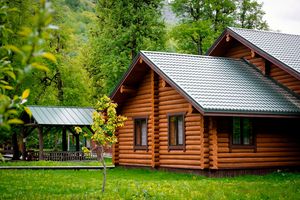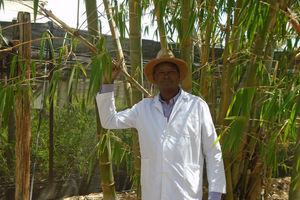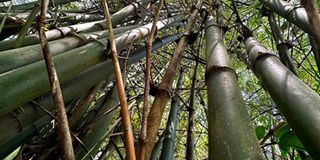
A dense Bamboo canopy in a plantation demonstrates the incredible heights attained by the plant.
In September 2020, the Kenyan Parliament classified bamboo as a cash crop, making it the country’s 16th cash crop. This classification aimed to encourage the commercialisation of bamboo while benefiting farmers across the country.
Bamboo is one of the most versatile plants and has numerous uses - from making furniture and interior décor items to construction, energy production, conservation and environmental restoration. The plant holds the Guinness World Record for the fastest growing plant, with some species estimated to grow 91 cm in a day.
On paper, bamboo is an excellent, sustainable and highly renewable resource. However, despite boasting about 140,000 hectares of bamboo, the plant is critically underutilised in Kenya, according to the Bamboo Association of Kenya. The Association points to lack of awareness, lack of equipment for processing and poorly developed market structures, among some of the reasons why Kenyan farmers are yet to benefit from their bamboo plantations.
A Kenyan Company, “We Do Bamboo” is, however, working to change this. The company specialises in sustainable construction and is partnering with Kenyan farmers to outsource and produce bamboo materials such as boards, flooring, decking, and beams - as alternatives to traditional materials like timber, concrete, and steel. Ultimately, the company aims to help reduce deforestation and cut down on carbon emissions across East Africa while boosting local supply chains for construction materials.
DN2 Property spoke to Arthur de Leeuw, an entrepreneur and the CEO at We Do Bamboo. He takes us through the company’s journey, bamboo’s potential in the construction industry and the challenges in optimising the plant’s use in Kenya.

Arthur de Leeuw, an entrepreneur and the CEO at We Do Bamboo.
Take us back to the moment that inspired the formation of We do Bamboo. What gaps, needs or opportunities did you see in the Kenyan market?
The idea really goes back to a news segment I watched on the evening news, when I was in the Netherlands about bamboo farmers in Portugal. It was fascinating to see how bamboo was being embraced as a new crop in Europe. That sparked something in me, and I began researching how bamboo could be used more widely. As I dug deeper, I realised that in Kenya, a lot of bamboo had been planted over the years, but it was not fully utilised or processed.
Kenya, like many other countries, has been heavily dependent on imported materials for construction, which puts a strain on both the environment and the economy. I realised that if we could tap into bamboo, we could reduce that dependency, create jobs, and fundamentally change how we build, all while contributing to a greener future.
How does We Do Bamboo’s model work and how do you envision it transforming the local construction industry?
We Do Bamboo operates on a "forest-to-market" model, working closely with local farmers to source bamboo while ensuring quality and sustainability. With the help of advanced technology, the company processes bamboo to meet the specific needs of Kenya’s diverse climates.
But it’s not just about products, we are committed to empowering local communities, creating jobs, and promoting sustainable farming practices.
Our vision is to make bamboo a mainstream choice in the Kenyan market, reducing the environmental impact of construction while supporting local communities. We believe Kenya is ready for a thriving bamboo industry, and we want to bring that to life locally. Our philosophy is that Kenya should rely less on imports and produce more locally.
Elaborate on the range of bamboo-based building materials you plan to produce and their specific applications in construction.
We will kick things off with Bamboo Plastic Composites (BPC). BPC is a combination of Bamboo fibres and plastic composites. We will use the BPC to produce decking and cladding products and decorative wall panels. By mixing bamboo powder with recycled plastic, we create a super durable end product, which requires no maintenance. Once we get that going, we will expand into more traditional bamboo products like laminated boards and beams.
How does Bamboo compare to traditional materials such as steel, concrete and wood in terms of performance?
Bamboo stands up really well against these traditional materials. It has excellent tensile strength and good compressive strength (strong under pressure). Bamboo as a material is lightweight, flexible, and cost-effective. Plus, it is a much more sustainable option.
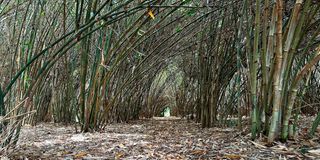
A bamboo plantation in Nyeri County.
When it comes to cost, it’s important to note that the price of bamboo-based products like BPC cladding and decking can vary depending on the type of wood you are comparing it to. While bamboo might have a slightly higher initial price compared to more affordable softwoods like pine or fir, it is often priced similarly to or even cheaper than premium hardwoods like oak or teak.
Bamboo offers incredible long-term value because it’s incredibly durable, with products lasting 15 years or more, while wood, especially softwoods, typically needs more frequent maintenance and replacement. Over time, the costs of maintaining and replacing wood can add up, making bamboo a more cost-effective choice in the long run.
We also have to take sustainability into account. Bamboo is a rapidly renewable resource which reduces the environmental costs linked to deforestation. As the bamboo industry grows in Kenya, we expect the cost of production to drop as we scale, making eco-friendly bamboo products even more accessible and affordable.
How does your production process ensure environmental sustainability, and what measures are in place to minimise ecological impact?
Bamboo can be harvested in about four years, much faster than wood, which takes 20 years or more. That in itself is a sustainability measure. The plant is also excellent at storing CO2, and by turning it into products that last 15 years or more, we help reduce carbon emissions. Our production methods are energy-efficient, and we minimise waste through careful planning and recycling. Additionally, our factory operations are designed to minimise environmental impact, from water use to emissions.
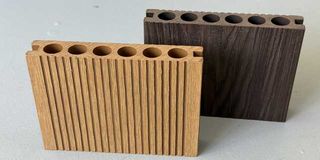
Wood Composite floor decking panels. We Do Bamboo is recreating this wood aesthetic in flooring materials using bamboo.
Tell us more about your collaboration with local farmers. How does this partnership benefit them?
Over the years, farmers have been encouraged by Non-Governmental Organizations (NGOs) and other organisations to plant bamboo (for environmental and reforestation purposes), but there’s been no real market for it. Many farmers are now looking at their bamboo and thinking, “what do we do with this?” Some have even destroyed it to plant other crops. That’s a real waste, and we want to show these farmers that their hard work hasn’t been in vain. By working closely with them to source, grow and harvest bamboo sustainably, this partnership provides farmers with steady income, creates jobs, and contributes to the development of the local economy.
Are Kenyan farmers able to meet the factory's supply needs, and how open are they to the idea of planting Bamboo for commercial purposes?
In terms of meeting the factory’s supply needs, we’re optimistic. Kenya has a significant amount of bamboo already planted.
Read: From food to medicine and construction materials, fast-growing bamboo will offer more than you need
As for how open Kenyan farmers are, to planting bamboo, there’s definitely interest. Now that we are creating a steady demand, more farmers are getting on board. Most farmers we speak to understand that bamboo offers an attractive income model. A single bamboo seedling can be used for harvesting bamboo poles for decades, making it a long-term, sustainable crop. This is especially appealing, as long as there’s a reliable buyer for their bamboo. We do need to provide training and support to help them get started and ensure sustainable practices. In summary, while there’s still some work to do in terms of education and awareness, we’re seeing a growing openness among farmers, and the infrastructure to support them is starting to take shape.
Considering the sensitive nature of construction projects - how will you ensure quality control and efficiency of the products?
We’re using some cool technology to make sure everything is produced with top quality and efficiency. We’re bringing techniques to Kenya that haven’t been used for bamboo here before, so it’s exciting to be pioneering that. Our factory will use automated machinery for precision and consistency, ensuring that each product meets the highest standards for construction applications.
When are these construction products expected to hit the Kenyan market and what preparatory stages have you covered so far?
We’re ready to start producing our BPC products in September. Once we’ve gained some traction, we’ll move forward with a second production line for laminated boards and beams. We've completed critical stages like building the machinery, picking the location for our factory, sourcing materials, and building partnerships.
What challenges have you faced so far in setting up a large-scale Bamboo processing factory in Kenya and how do you see the role of bamboo evolving in Kenya's construction landscape?
Setting up a factory, or any business for that matter, is always challenging. In this case, especially with infrastructure and supply chain issues. A big challenge is that bamboo grows all over the place – one farmer might have an acre, another just a few plants. Organising the supply chain is crucial, and we are solving that by setting up collection points in different parts of the country. We are also using technology that’s never been applied to bamboo in Kenya before. We will be investing a lot in training our staff to get them up to speed with the new processes.
However, the future of bamboo in Kenya’s construction industry looks promising. We see bamboo becoming a key player in sustainable building, especially as the demand for eco-friendly materials grows. There is so much fantastic bamboo to work with, and we can create amazing products that can replace less sustainable materials like wood, concrete, and steel – and it’s all “made in Kenya.”
On a global scale, how else has bamboo been adapted? Perhaps you can share some interesting cases for inspiration.
Bamboo is being used in exciting ways around the world. In Bali, the Green School showcases bamboo’s versatility with buildings made entirely from it, while the Green Village demonstrates bamboo's potential in luxury homes. In Vietnam, a 22-story apartment complex utilises bamboo for shading and energy efficiency. In China, the Crosswaters Ecolodge features the world’s largest bamboo construction, and in Mexico, bamboo helps the Luum Temple to withstand extreme weather.
In the U.S., companies like Smith & Fong (makers of Plyboo) use bamboo for everything from flooring to wall panels, making it a popular eco-friendly alternative. In Spain, the Adolfo Suárez Madrid-Barajas Airport features a massive bamboo ceiling, showcasing bamboo’s potential in large commercial spaces.
Closer to home, we have a great relationship with AkeKa, a company leading sustainable construction across East Africa. They use bamboo in their projects, and their commitment to innovation aligns with ours. In Nairobi, we’re also seeing more and more composite materials, like bamboo-based products, being used in new buildings—especially for façades, pool areas, and interior wall panels in hotels, giving them a modern, luxurious, international feel.
These examples show bamboo’s versatility and sustainability. For Kenya, these global lessons offer great insights into how we can use bamboo to create innovative, sustainable solutions for the future.

